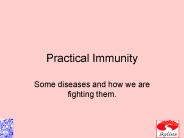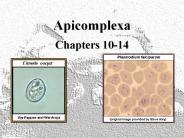Merozoites PowerPoint PPT Presentations
All Time
Recommended
Animated lifecycle of the malaria parasite TRANSMISSION TO MAN TRANSMISSION TO MAN LIVER Sporozoites Nucleus Hypnozoite Sporozoites 15-30 mins P. vivax dormant stage
| PowerPoint PPT presentation | free to download
Malaria Beef tapeworm in humans 25 Mechanical vector pinworm Trichinella Dinoflagellates Gonyaulax sp Red Tide Mastigophora Trypanosoma sp. Tsetse fly ...
| PowerPoint PPT presentation | free to view
PHYLUM APICOMPLEXA: coccidians. Morphology and General Life Cycle. apical ... develop blindness, mental retardation, hydrocephalus; major cause of birth defects ...
| PowerPoint PPT presentation | free to view
Apicomplexa originally called sporozoa no free-living forms complex life cycles spore-like forms intracellular stages defined by apical organelles invasive stages
| PowerPoint PPT presentation | free to download
Sporozoites enter The liver Detoxified by heme polymerizase forming hemozoin Mosquito infects human with plasmodium sporozoites upon biting Sporozoites reproduce
| PowerPoint PPT presentation | free to download
Malaria is a vector borne parasitic disease caused by the genus Plasmodium, affecting over 100 countries of the tropical and subtropical regions of the world.
| PowerPoint PPT presentation | free to download
Title: PowerPoint Presentation Author: Administrator Last modified by: John R. MacArthur Created Date: 5/7/2002 9:23:43 AM Document presentation format
| PowerPoint PPT presentation | free to view
Mycology is the study of fungi ... Arthropods as Vectors. Figure 12.31, 32. Arthropods as Vectors. Figure 12.33. Putting it Together ...
| PowerPoint PPT presentation | free to view
Title: Ameoboid Author: Lovrien Last modified by: lovrienj Created Date: 2/14/2005 4:21:55 PM Document presentation format: On-screen Show Company
| PowerPoint PPT presentation | free to download
Plasmodium Introduction 1- Most important parasitic disease affecting human. 2- Most common in Tropic Subtropics mostly Africa, Asia & S. America
| PowerPoint PPT presentation | free to view
MALARIA 40% of the world s population lives in endemic areas 3-500 million clinical cases per year 1.5-2.7 million deaths (90% Africa) increasing problem (re ...
| PowerPoint PPT presentation | free to download
Unit 6 Lesson 1 Health Care
| PowerPoint PPT presentation | free to view
Malaria Pathogenesis and Clinical Presentation Gail Stennies, MD, MPH Malaria Epidemiology Branch May, 2002 Plasmodium species which infect humans Malaria ...
| PowerPoint PPT presentation | free to view
Eukaryotic Microbes Parasites Protozoa, Helminths, Arthropods Eukaryotic Microbes Protozoa Life Stages Trophozoite -vegetative; feeding, mostly motile Cyst ...
| PowerPoint PPT presentation | free to download
Eukaryotic Pathogens: Algae and Protozoans What types of eukaryotic organisms are pathogenic, and how do they differ from bacteria? Algae: dinoflagellates and saxitoxin
| PowerPoint PPT presentation | free to view
Schizogeny asexual reproduction that results from multiple mitosis by ... Lab tests such as necropsy or biopsy eith organism is definitive; ELISA or molecular tests ...
| PowerPoint PPT presentation | free to view
... Prevention of amoebic liver abscess during ttt of intestinal amoebiasis treatment of ... sweeting,nausea,vomiting ... PowerPoint Presentation ...
| PowerPoint PPT presentation | free to download
Series of sacs or alveoli underneath cell membranes ... http://www.geo.ucalgary.ca/~macrae/palynology/dinoflagellates/theca.gif. Ciliates ...
| PowerPoint PPT presentation | free to view
Table of various host-parasite relationships. Considerations: Host type vs host ... Class: Sarcodina (amoeba) motile by 'pseudopods' several genera: Entamoeba, ...
| PowerPoint PPT presentation | free to view
have full detail
| PowerPoint PPT presentation | free to download
https://www.facebook.com/ fb
| PowerPoint PPT presentation | free to download
Malaria Cycle (Hviid, 2004) (Marsh et al, 2004) Variant Surface Antigens (VSA) ... An antigenically conserved group, in time and space, associated with severe disease. ...
| PowerPoint PPT presentation | free to download
Life Cycle of Plasmodium Review of Mosquito Cycle. from text page 150 ... Oocysts on outside of mosquito stomach. Sporozoites from salivary gland ...
| PowerPoint PPT presentation | free to view
MALARIA Four Plasmodium species are responsible for human malaria: P. falciparum malignant tertian malaria P. vivax, benign tertian malaria P. ovale ...
| PowerPoint PPT presentation | free to download
Protozoa Phyla List of Phyla Amoeba-like organisms (e.g., Amoeba) Phylum Euglenozoa Subphylum Euglenida (e.g., Euglena) Subphylum Kinetoplasta (e.g., Trypanosoma ...
| PowerPoint PPT presentation | free to view
this is ppt sample
| PowerPoint PPT presentation | free to download
Fig. 14-1, p. 344 * Figure 14.1: There is concern that bisphenol A (BPA), an estrogen mimic, can leach out of polycarbonate baby bottles, especially when they are ...
| PowerPoint PPT presentation | free to view
This sample Of PPT.............
| PowerPoint PPT presentation | free to view
Chapter 26: Protozoa 26-1 Overview of Protozoa 26-2 Protozoan Diversity (2) Sporozites (liver-stage parasite) When an infected mosquito bites a person, Plasmodium ...
| PowerPoint PPT presentation | free to view
Malaria parasite (plasmodium) Pathogen of malaria P.vivax ; P.falciparum ;P.malariae ; P.ovale P.vivax ; P.falciparum are more common Plasmodium is a wide ...
| PowerPoint PPT presentation | free to view
Malaria HIV HepB a subunit vaccine. Tissue Transplant Asthma Leishmaniasis Botfly Larvae: MYIASIS Malaria Kills 1-3 million people a year.
| PowerPoint PPT presentation | free to download
Haemophilus influenzae type b meningitis: Polysaccharides conjugated with protein ... Botfly Larvae: MYIASIS. Malaria. Kills 1-3 million people a year. ...
| PowerPoint PPT presentation | free to view
1-3uM trophs in RBCs resembling early ring forms of Plasmodium falciparum ... homological characteristics that conflict to resemble both a protozoan and a fungus. ...
| PowerPoint PPT presentation | free to view
Done to verify that a chosen gene has been incorporated into the DNA of the ... This shape causes them to get tangled up and clog the spleen and blood vessels. ...
| PowerPoint PPT presentation | free to view
... more concentrated good screening test positive or negative ... RDTs Polymerase Chain Reaction ... 10% blood volume used in PCR reaction ...
| PowerPoint PPT presentation | free to view
Some heterotrophic protists obtain food by absorption ... Some (like Euglena) can alternate between autotrophism and heterotrophism ...
| PowerPoint PPT presentation | free to view
Malaria HIV, malaria and TB are among the most important infectious agents in the world. There are no vaccines against them, and all have the same property of ...
| PowerPoint PPT presentation | free to download
Blood and Tissue Protozoa Mark F. Wiser Department of Tropical Medicine School of Public Health Protozoa of Blood and Tissues Trypanosoma cruzi and Chagas Disease ...
| PowerPoint PPT presentation | free to view
Mitochondria break down and release cytochrome c into the cytoplasm. DNA condenses and fragments ... Few host mitochondria retain membrane potential. Not quite ...
| PowerPoint PPT presentation | free to view
MALARIA Department of Infectious Diseases Third Affiliated Hospital Sun Yat-sen University Lin Yang A parasitic diseases caused by plasmodium species.
| PowerPoint PPT presentation | free to view
Dogs Brazil Yai et al, 1997. Absent in: Domesticated animals, Haiti ... Perform tissue biopsies in animals shedding C. cayetanensis oocysts to determine ...
| PowerPoint PPT presentation | free to view
... 1-10 yrs 2-3yrs 2-4 yrs 1 yr x Transfer Process to Manufacturing Build Facility II Research (Inc ... trial of Malaria vaccine Animal ...
| PowerPoint PPT presentation | free to view
GI intolerance. Nausea, vomiting, abdominal pain, headache ... The systemic elimination of chloroquine is about 50% and remaining amount is eliminated by the renal ...
| PowerPoint PPT presentation | free to download
Viral History Discovery of Viruses Beijerinck ... A virus is a non-cellular particle made up of genetic material and protein that can invade living cells.
| PowerPoint PPT presentation | free to download
Nematodes are their own phylum (roundworms vs annelids) ... Phylum nematode: roundworms are cylindrical, non-segmented worms (vs Cestodes & Annelids) ...
| PowerPoint PPT presentation | free to view
... 14-2 In terms of death rates, the most serious infectious diseases are flu, AIDS, ... Pneumonia and flu (bacteria and viruses) Disease (type of agent) ...
| PowerPoint PPT presentation | free to view
Title: No Slide Title Author: Duen Last modified by: com Created Date: 11/26/2001 5:58:30 PM Document presentation format:
| PowerPoint PPT presentation | free to view
viruses Living Nonliving Contain a single type of nucleic acid (DNA or RNA), protein coat, sometimes an envelope. Are obligatory intracellular parasites.
| PowerPoint PPT presentation | free to download
Inefficient transmission (parasite in feces of bug) ... microscopic demonstration of parasite in blood smear (distinguish species) ...
| PowerPoint PPT presentation | free to view
... with a pruritic rash on his right buttock accompanied by flu-like symptoms. ... non-specific flu-like signs, and the use of automated cell readers that cannot ...
| PowerPoint PPT presentation | free to view
Another type of Balantidium coli is cysts. Down on the left is a picture of active trophaziots. ... Another type of Balantidium coli is cysts. ...
| PowerPoint PPT presentation | free to view
previously known as cyanobacterium-like or coccidia-like body (CLB) ... although has been isolated from non-human primates (chimpanzees and baboons) ...
| PowerPoint PPT presentation | free to view
Fungi can be beneficial or harmful ... Hermaphrodite releases eggs which may be coughed out or swallowed then released by feces ...
| PowerPoint PPT presentation | free to view
Presentation about theileriosis by Ahmed Abdulkadir Hassan, 4th year student in college of veterinary medicine, University of Bahri. (2012).
| PowerPoint PPT presentation | free to view
Surface/Apical Proteins of ... Surface/apical proteins implicated in attachment and/or invasion ... identified by surface and apical-reactive MAbs C4A1, 3E2 ...
| PowerPoint PPT presentation | free to view
























































